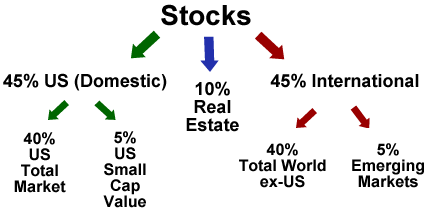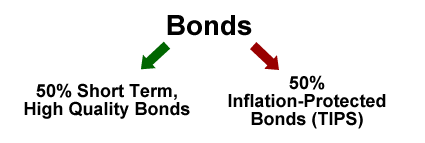Scott Burns of Assetbuilder has a new article that shows the benefit of diversifying your portfolio beyond the often-cited S&P 500 index fund that you probably have in your 401(k) plan. During the recent financial crisis, nearly every asset class involving stocks crashed. Large cap stocks, small cap stocks, REITs, international stocks.
From January 2000 to December 2009, the total return (not annualized) of the S&P 500 was negative 9.67%. That means money that you invested in the S&P 500 in 2000 was worth about 10% less an entire decade later. This is the so-called “lost decade” that numerous media articles have focused on.
Well, if you’ve been following this blog since 2004 or many other similar ones, you would have also read about research and historical data that advises you to diversify your investments across some other asset classes. Here are the total returns of other asset classes during that same 10-year period:
* Domestic large cap value stocks returned 53.7 percent
* Domestic small cap value stocks returned 139.5 percent
* REITs returned 170.9 percent
* Large cap international stocks returned 15.1 percent
* International large cap value stocks returned 90.7 percent
* Emerging markets stocks gained 147.8 percent
* Domestic micro-cap stocks, domestic small cap value, international small cap value, emerging markets value stocks, and emerging markets small cap stocks all enjoyed enormous gains. Emerging markets value stocks, for instance, returned 266.7 percent.
The S&P 500 is a good proxy for large-cap stocks in the US, but it doesn’t necessarily make your portfolio complete. Adding other asset classes that zig when others zag can help. Below is a summary of my target allocation, with further details here.


This is not a blanket recommendation for everyone, just an example of what I’m invested in to provide a nudge to read some more.
 The Best Credit Card Bonus Offers – 2025
The Best Credit Card Bonus Offers – 2025 Big List of Free Stocks from Brokerage Apps
Big List of Free Stocks from Brokerage Apps Best Interest Rates on Cash - 2025
Best Interest Rates on Cash - 2025 Free Credit Scores x 3 + Free Credit Monitoring
Free Credit Scores x 3 + Free Credit Monitoring Best No Fee 0% APR Balance Transfer Offers
Best No Fee 0% APR Balance Transfer Offers Little-Known Cellular Data Plans That Can Save Big Money
Little-Known Cellular Data Plans That Can Save Big Money How To Haggle Your Cable or Direct TV Bill
How To Haggle Your Cable or Direct TV Bill Big List of Free Consumer Data Reports (Credit, Rent, Work)
Big List of Free Consumer Data Reports (Credit, Rent, Work)
Here is my two cents:
– Only 202 of the 500 biggest companies in the United States in 1980 were still in existence 20 years later.
– On December 29, 1989, Tokyo’s Nikkei stock average reached its all-time peak of 38,915.87. Twenty years later, the Nikkei has never again reached that level — and, in 2009, reached a new low of 7,054.98.
You might not see your money again. That is why I am very skeptical about 7% annualized return. This is over optimistic, imho.
This is a great argument supporting diversification, and, with the large variety of returns among all of those asset classes, can really be extrapolated to make a great argument for rebalancing as well. Nice and concise, thanks!
diversification is great if you want balanced investing with lower risk.
so that begs the question, what segment did so terribly to bring the others down? if large and small cap did great, was it mid-cap (is there such a thing) in the s&p500 that brought it down? or just non-value did terribly? either way, whatever segment it was, have your eye on that
gt: note that the only listed segment that overlaps with the S&P 500 is large cap value (+53%). The others have no overlap.
I suspect the portion of the S&P 500 most responsible for the bad performance is large-cap growth. As a quick (but not final!) check, I checked the prices of Vanguard’s Growth Index (VIGRX) from Jan. 3 2000 to Dec. 28 2009. Do note that this doesn’t include dividends (so it overstates the losses) and the fund isn’t an exact match to the S&P 500 (it’s broader); but that fund’s NAV went down 28.82% over the decade period.
http://finance.yahoo.com/echarts?s=VIGRX+Interactive#symbol=vigrx;range=20000103,20091231;compare=;indicator=volume;charttype=area;crosshair=on;ohlcvalues=0;logscale=off;source=;
Over the same period, the price of the Vanguard Value Index fund (VIVAX) went down by 17.82%. Vanguard Small Cap Value index gained about 60%, Vanguard Small Cap Growth Index gained a tiny bit less (I’m eyeballing the graph at 58%), and the Mid Cap Index lost about 5% (eyeballing the graph again). (Remember again, these numbers don’t count dividends, which means they overstate losses and understate gains, especially for the value indexes.)
I think this is misleading. My first reaction was, how did the S&P do so poorly, given that a diverse set of asset classes all had positive returns?
Then I read closer and found that he has isolated value stocks in many of the categories. For an honest portrayal of how diversification would be helpful, he should have shown how a balanced portfolio would have performed. Cherry picking asset classes and pointing at them is not very informative, and in this case I think he is using them to oversell the case for diversification (which, looking at his website is what he’s in business to sell).
Those returns are bogus. Diversification is great but lets keep it real!
Hi Jonathan, its also worth checking out this article on the subject: http://www.jemstep.com/blog/2011/03/investing-from-2000-to-2010-the-%E2%80%98lost%E2%80%99-decade-perhaps-not/.
Touches on the exact same point, with detailed metrics.
Regards,
kevin
I’ve read articles, I’m pretty sure, that give data showing how being a part of the S&P 500 can falsely inflate a stock when it’s first included since so much money is concentrated in following the index. Effects like that highlight how the s&p 500 has almost it’s own market bubble effect which is enough to convince me that all of my dollars should not be banking on it.
@adamp
Don’t think you can call it cherry picking when a lot of the slice and dicers like Larry Swedroe (who’s been mentioned quite a bit on this blog) specifically suggest a value tilt. Apparently, Fama and French did studies that showed outperformance by large and small value over extended periods, suggesting that value stock investors may be rewarded for taking extra risk over growth stocks. Many who follow this blog (and the linked Scott Burns blog as well as the books of Swedroe, Bernstein, and others) probably similarly tilt towards value. It’s not market weight, but it’s certainly not cherry picking to add LV and SV tilt.